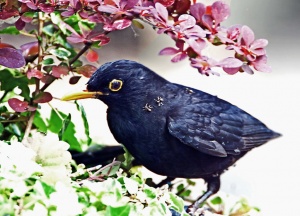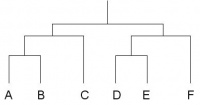This section is aimed at explaining the bird and biology specific vocabulary you are likely to meet in other threads in Birdforum.
This page is divided into several sections: Dictionary A-C, Dictionary D-F, Dictionary G-L, Dictionary M-O, Dictionary P-S and Dictionary T-Z.
A
Albinism, albino: a bird or other animal completely lacking pigment in both feathers/hair/skin, eyes, legs, toes and nail, bills, and all other surfaces of the animal. White Monjita, Snow Goose, Swans, and other birds that are normally white are not albinos: they lack the pink eyes and bill/legs taking the color only from the blood running through the area, and instead have fully colored bare parts and sometimes even black in specific parts of the plumage. A true albino is a rarity, a result of some type of mutation inactivating the production of all types of pigment colors, melanins and carotenoids. The opposite of albinism is melanism. See also "Partial albinism" and "Leucism".
Even though the following gallery search claims to search for Dictionary A-C, it actually search for "albinism" or "albino" or "Leucism" or "leucistic". Just be aware that some of the photos found might be of photos showing the opposite, but where one of these words are mentioned in the text!
Allopatry, allopatric: word used to describe that two populations (often species or subspecies) have non-overlapping ranges.
Allopreening, mutual preening: describes situations where one bird is preening another bird, usually of the same species. Allopreening frequently involves areas of the head and neck. For some species, this is especially common during pair bond formation.
Alternate plumage: usually synonymous with breeding plumage (nuptial plumage). In most non-tropical species, this plumage is worn during spring and summer, but in Anas ducks, northern hemisphere male ducks will wear this plumage during winter to late spring. Some species have only one annual molt and really show only one plumage year round; if so, they are going to be considered to be in basic plumage (which see) year round. In some birds, the change from basic to alternate plumage is the result of wearing off disguising feather tips to reveal inner more strongly patterned feather parts instead of partial or complete moult leading to alternate plumage.
Altricial: about birds that hatch as blind, without down, and generally helpless. Most passerines fall into this group. The opposite is Precocial, but in reality, many birds hatch in a state between the extremes, so that there is a continuum rather than two clearly separated groups. See also Semi-altricial.
Alula: see Wings
Anisodactyl: The arrangement of toes on a birds foot where the inner toe points backwards and the others point forwards. The majority of passerines have this type of foot, some of the non-passerines do too but not the majority. see Legs and Feet

Photo by 02pepe47
A Cheshire garden, August 2015
Click on image for larger version
Anting: a behavior for control of ectoparasites that can occur in one of two ways: either the ants are encouraged to spread over the body of the bird and actively eat the parasites or ants are crushed to release the formic acid and this paste is spread over the feathers. The behavior is probably more common in passerines than in other birds.
asl: frequently used abbreviation for "above sea level" especially when describing elevation ranges of montane birds.
Assortative Mating: the observation that two groups of birds prefer mating with members of their own group even though the two groups coexist in the same area or even breed in the same colonies. When the groups involved are considered subspecies of the same species, then Assortative Mating can be used as an argument for these being raised to be full species.
Auriculars: see Heads
Austral: about things pertaining to the southern hemisphere.
Austral migrant: a migratory species that breeds south of the equator and migrates north in southern/austral winter. Many birds breeding in southern Argentina and Chile fall in this category.
Axillaries: the feathers found in the armpit of a bird when seen from below. These are sometimes important for correct identification, for example in American Wigeon and Grey Plover. See Wings
B
Bare parts: in bird descriptions, a collective designation for legs, bill, cere, and if applicable, of other bare skin areas such as bare skin around the eyes in for example Bare-crowned Antbird
Basic plumage: mostly synonymous with non-breeding plumage (non-nuptial plumage). In most non-tropical species this is the plumage worn during winters, but in Anas ducks, this is named the Eclipse plumage (which see) and is worn in summer and fall. Opposite is Alternate plumage.
Bergmann's rule: a zoogeographic rule stating that animals living in a warmer climate tends to be smaller than those living in a cooler climate.
Bill-tip organ: this is a structure found near the tip of the bill in several types of birds that forage by probing. This consists of pits in the bill surface which in the living bird is occupied by cells that sense pressure changes. The assumption is that this allows the bird to perform "remote touch" which means that it can detect movements of animals which the bird does not directly touch. Bird species known to have a "bill-tip organ" includes members of Ibisis, Shorebirds of the family Scolopacidae, and Kiwis[1]. There is a suggestion that across these species, the bill-tip organ is more well developed among species foraging in wet habitats (water column or soft mud) than in species using a more terrestrial foraging.
Branchling: a term most often used for Owls. This describes a bird after it leaves the nesting burrow but before it is able to fly, when the bird often will use its legs to scramble onto a branch near the hole.

Photo © by Digiscoper321
West Sweden, 12 June 2020
Broken wing display: where an adult bird pretends to be injured, so as to distract predators away from its nest or chicks; the predator sees a bird fluttering apparently helpless, and goes after it in the prospect of an easy meal, only for the 'injured' bird to fly away once it has led the predator well away from the nest. Performed mainly by plovers.
Brood parasite: A species that lays its eggs in the nest of other species and leaves the work with raising the young to them. (Also known as nest parasite).
Brood patch: An area (or sometimes more than one) usually on the lower breast or belly that looses its feathers in order for the incubating bird to have more efficient heat transfer to the egg(s). The area often has increased blood flow and sometimes also increased liquid filling as additional adaptations to increase heat transfer. In many species such patches are found only in one sex, the sex that does most of the incubating. These patches should more properly be called incubation patch(es). Feathers grow back in the area at the first moult after incubation.
Bristles: see Heads
References B
- Cunningham et al. (2010). Bill morphology or Ibises suggests a remote-tactile sensory system for prey detection. The Auk 127:308-316.
C
Casque: An enlargement of the upper mandible (e.g., Hornbills) or a bony outgrowth on top of the head (e.g., Cassowaries). The casque is often a structure of mainly ornamental function that is selected for by the opposite sex in sexual selection.
Cere: see Heads

Clade: a group of species that include all descendants from a common ancestor. In a phylogenetic tree, this will be visible as a number of branch ends that originate in one point (node) in the tree: in the drawing, species A, B, C are one clade, D, E, F are another.
Clay-lick: areas of exposed clay where especially macaws and other types of parrots/parakeets eat small amounts of clay on a daily basis. The explanation for this behavior is not certain, but there are indications that the clay binds toxins that thereafter come out in the faeces. That allows the parrots to eat food containing toxins that they would otherwise not survive eating.
Clinal variation, Cline: variation within one taxonomic unit (either species or subspecies) that is correlated with geography, so that for example birds living in colder climates are larger than members of the same species living in a warmer climate (many species, Bergmans's rule) or north-eastern birds are brighter coloured than south-western (e.g., Chestnut Woodpecker). The important part of this concept is that the shift from one type to another is gradual, not abrupt.
Colony, colonialism: members of some species breed very close together with only the nest and its immediate surroundings defended against other members of the same species. One disadvantage of such a breeding system is that the members on average will have to fly far to collect sufficient food for the young. The ideas about what the possible advantages could be are many, but one is that being in a colony could help protect against predation of eggs and/or chicks. This seems to be borne out in some cases, for example in Royal Tern where the pairs nesting centrally in colonies seem to suffer fewer losses than those nesting in the periphery[1].
Congener, congeneric: that two or more species belongs to the same genus
Conspecific: That two or more taxons are considered parts of the same species or in other words that each of them are considered to be subspecies, not species.
Convergent evolution: Where two species that are not each others' closest relatives evolve to resemble each other more than they resemble their closest relatives. For example, Bridled Titmouse (left) and Crested Tit (right) are not each others' closest relatives, yet look strikingly similar. This often occurs where the two species live in similar habitats and face similar evolutionary pressures.
Photo: UncleGus_24
Arizona
Coronal: the area of the head of a bird also known as the crown, containing the medial and lateral crown stripes on birds that have these (see Topography#Heads).
Crepuscular: about a bird that is more active at dawn and dusk than at other times of the day or night. See also diurnal and nocturnal.
Crissum: combination of undertail coverts and the area around the vent
Cryptic: about plumage or general appearance, to denote a species or sex that is less easy to find. Sometimes called camouflaged.
Culmen: see Beak
CY = calendar year: one of the systems used to tell the age of a bird. In this system, a bird is 1cy from the day it hatches until midnight on 31 December, it is 2cy (second calendar year) for the next 12 months, etc. In some ways this is more intuitive than a system like "first summer" (see this), but is also has some disadvantages: the switch in designation is not coupled to moult, so to give a description of a photo, one would have to know the date at which it was taken; and for some (mainly tropical and southern hemisphere species), a single nest could contain siblings hatched successively on 31 December and 1 January, which would be 2cy and 1cy respectively despite having identical plumage.
References C
- Angulo-Gastelum, UT, et al. 2011. Breeding ecology of the Royal Tern (Thalasseus maximus) at Isla el Rancho, Mexico: colony size and nest location affect predation. Ornithologia Neotropical 22:131-142.
This page is divided into several sections: Dictionary A-C, Dictionary D-F, Dictionary G-L, Dictionary M-O, Dictionary P-S and Dictionary T-Z.





